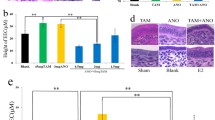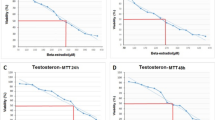Abstract
The effects of equimolar doses of the triphenylethylene antiestrogens tamoxifen and toremifene on female Sprague-Dawley rat liver were studied in a 52-week toxicity study which included a 13-week recovery period. Liver tumors were found in four out of five rats at the highest dose level of tamoxifen (45 mg/kg per day) after 52 weeks of dosing, and these appeared to be hepatocellular carcinomas in three rats. After the 13-week recovery period all surviving rats in the highest tamoxifen dose group had large liver tumors (diameter up to 2 cm) which appeared to be hepatocellular carcinomas in five out of six rats. No tumor was observed in the toremifene-treated rats (48 mg/kg per day) either after 52 weeks of dosing or after the recovery period. Electron microscopic morphometric analysis after 52 weeks of dosing revealed that at the tamoxifen high dose level, the volume densities of the peroxisomes, mitochondria, and residual bodies were elevated in the nonneoplastic hepatocytes of the rats. In the neoplastic hepatocytes of the tamoxifen-treated rats the volume density of nuclei was slightly elevated. The slight proliferation of peroxisomes and mitochondria might be related to tumor development in the tamoxifen treated rats.
Similar content being viewed by others
References
Cameron R, Imaida K, Tsuda H, Ito N (1982) Promotive effects of steroids and bile acids on hepatocarcinogenesis initiated by diethylnitrosamine. Cancer Res 42: 2426–2428
Di Salle E, Zaccheo T, Ornati G (1990) Antiestrogenic and antitumor properties of the new triphenylethylene derivative toremifene in the rat. J Steroid Biochem Mol Biol 36: 203–206
Furr BJA, Jordan VC (1984) The pharmacology and clinical uses of tamoxifen. Pharmacol Ther 25: 127–205
Furr BJ, Patterson JS, Richardson DN, Slater SR, Wakeling AE (1979) Tamoxifen. In Goldberg M (ed) Biochemical properties of drug substances, vol 2. pp 355–399
Ghia M, Mereto E (1989) Induction and promotion of γ-glutamyltranspeptidase-positive foci in the liver of female rats treated with ethinyl estradiol, clomiphene, tamoxifen and their associations. Cancer Lett 46: 195–202
Heel RC, Brogden RN, Speight TM, Avery GS (1978) Tamoxifen: a review of its pharmacological properties and therapeutic use in the treatment of breast cancer. Drugs 16: 1–24
Hirsimäki P, Nieminen L, Sairio E, Kärki T, Kärki N (1986) Toremifene: no effect in mutagenicity assays. Farmos report, Farmos, Finland vol 2, series A, no 3
Hirsimäki P, Hirsimäki Y, Nieminen L (1988) The effects of tamoxifen citrate and toremifene citrate on the ultrastructure of rat liver. In: Dickensian H, Goethe PJ (eds) Inst. Phys. Conf. Series no 93, vol 3. Bristol, pp 235⅔6
IARC Monographs (1979) The carcinogenic risk of chemicals in man. Sex Hormones 21: 147–364
Author information
Authors and Affiliations
Rights and permissions
About this article
Cite this article
Hirsimäki, P., Hirsimäki, Y., Nieminen, L. et al. Tamoxifen induces hepatocellular carcinoma in rat liver: A 1-year study with two antiestrogens. Arch Toxicol 67, 49–54 (1993). https://doi.org/10.1007/BF02072035
Received:
Accepted:
Issue Date:
DOI: https://doi.org/10.1007/BF02072035




